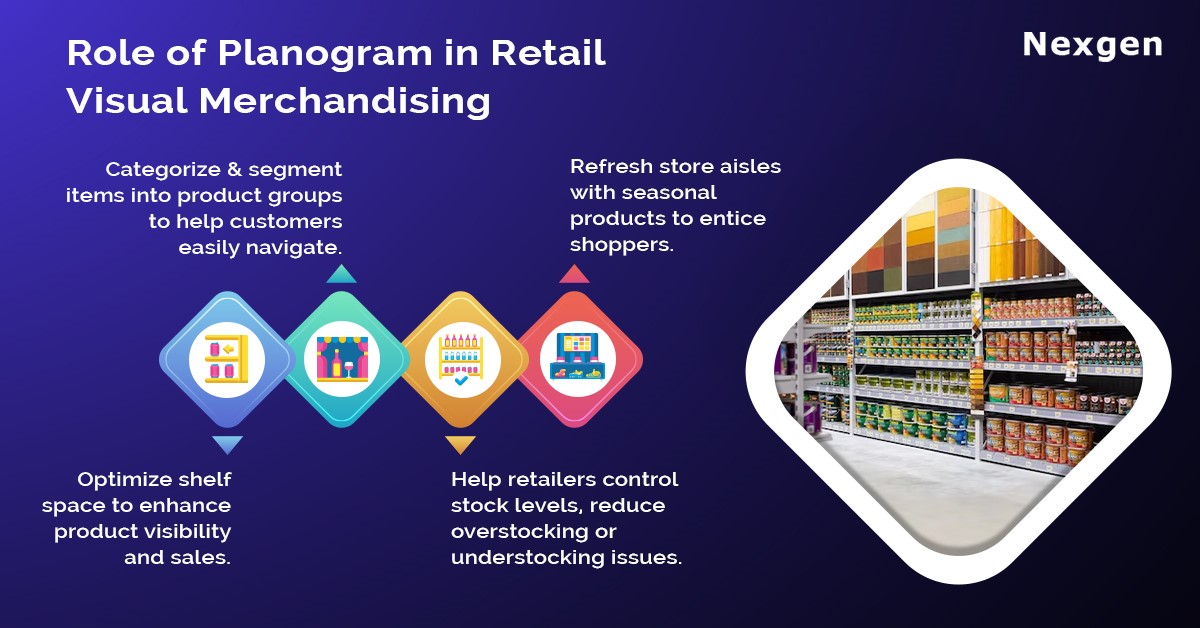In today’s retail world, creating a visually appealing and organized store layout is crucial to attracting and retaining customers. One essential tool that plays a pivotal role in achieving this is the planogram. In this blog, we will delve into what is a planogram is and how it serves as a cornerstone of retail visual merchandising.
What is a Planogram?
A planogram, often described as "POG," is a visual representation or diagram that outlines the precise placement and arrangement of products on store shelves or displays. Recent studies show that 80% of customers make impulse purchases when products are visually appealing on shelf layouts. For example, let us look at two examples. In the first case, the customer goes to the store to buy butter. In the second case, to purchase a soft drink. Did you ever notice that if you place bread or cheese at a discount price near the butter, it can increase the chance of your customer buying both items? Or, in the second example, placing chips and cookies near soft drinks can result in impulse buying. In both cases, customers make buying decisions based on how well each item is displayed on store shelves. Planograms can optimize the use of retail space to enhance product visibility, boost sales, and improve the overall shopping experience. Following are some features of a planogram in retail:
- Product placement: This is the core of a planogram, where each product's location on the shelf or display is meticulously planned. It considers factors like product size, shape, and popularity to create a logical and aesthetically pleasing arrangement.
- Space allocation: Planograms allocate specific shelf space for each product, ensuring no product dominates the display while others get overshadowed.
- Sales analysis: Planogram analytics features allow retailers to track the performance of each shelf. This helps them determine which layouts are most effective in driving sales and customer engagement.
- Planogram reference: This includes product details, such as SKU numbers, product names, and descriptions, making it easier for employees to locate and stock items accurately.
The Role of Planograms in Retail Visual Merchandising
In the competitive world of retail, the role of planograms in visual merchandising cannot be overstated. They offer a structured and data-driven approach to organizing products on store shelves, resulting in improved sales, better inventory management, and an enhanced shopping experience for customers. When executed effectively, planograms are a powerful tool that empowers retailers to stay ahead in the ever-evolving retail landscape.

- Optimizing shelf space: Planograms help retailers make the most of their available shelf space by arranging products efficiently. This ensures that every inch of retail space is used effectively, preventing overcrowding or underutilization.
- Enhancing product visibility:By strategically positioning products based on consumer behavior and purchasing patterns, planograms ensure that popular and high-margin items are prominently displayed. This can lead to increased sales, as customers are more likely to notice and purchase these products.
- Improving inventory management: Planograms provide a structured approach to inventory management. They help retailers control stock levels, reduce overstocking or understocking issues, and decrease the likelihood of out-of-stock for in-demand items.
- Creating a consistent brand image: Planograms ensure a consistent and visually appealing store layout, reinforcing the brand's image and identity. This helps build customer trust and loyalty.
- Enhancing the shopping experience: A well-executed planogram contributes to a more pleasant and efficient shopping experience. When customers can easily find what they are looking for, they are more likely to enjoy their shopping trip and return to the store in the future.
- Empowering store managers: Planograms serve as valuable training tools for store managers, guiding them on how to set up and maintain displays accurately. This reduces the chances of error and helps ensure that the store always looks its best.
Overview of Nexgen POG
Nexgen POG is a robust and user-friendly cloud-based visual merchandising tool. It is designed for quick and efficient planogramming with minimal effort. Planogram in retail can be designed by easily dragging and dropping the products. The multi-device compatibility feature of POG allows you to obtain, share and edit planogram on any device, including your phone. It helps in designing store-specific planograms for increased product visibility and sales.
Get Your Free Trial Now!